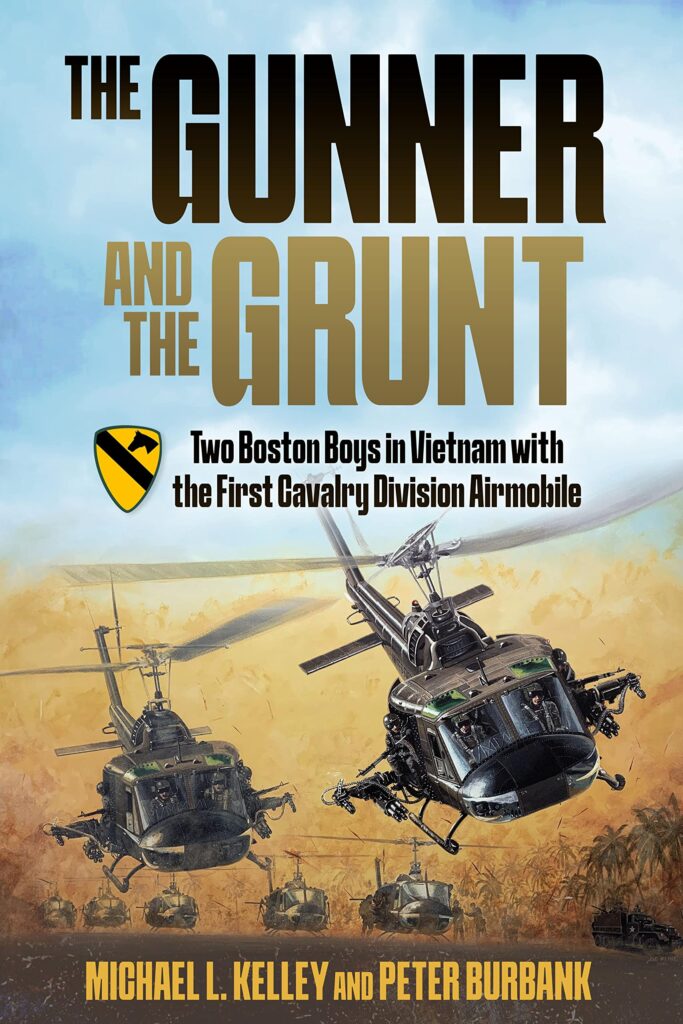By Michael L. Kelley and Peter Burbank.
Havertown, PA: Casemate Publishers, 2023.
ISBN 978-1-63624-343-6. Photographs. Appendices.
Pp. xxi, 196. $34.95.
Authors Mike Kelley and Pete Burbank provide a well-written account of how two men from Boston separately enlisted in the U.S. Army and deliberately sought combat assignments in Vietnam. They did not know each other until they met when both were assigned to the same unit in the 1st Cavalry Division (Airmobile) in late 1965.
Both Kelly and Burbank enlisted right after high school. Kelly wanted to be a helicopter mechanic, and Burbank wanted to be an airborne infantryman. Both got their wish. Their stories of separate basic training and advanced specialist training are both humorous and serious. After basic training, Kelly was assigned to a helicopter maintenance unit at Davison Army Airfield near Washington, DC. At almost the same time, Burbank completed training and became an airborne infantryman assigned to 1st Battalion, 501st Infantry, 101st Airborne Division. Both young soldiers had only a short time to serve stateside before being reassigned to tactical units in Vietnam.
The two men arrived in Vietnam in late 1965 and were assigned to Troop C, 1st Squadron, 9th Cavalry (1/9 Cavalry). Specialist 4 Kelley became a UH-1 Huey helicopter mechanic and crew chief in Charlie Troop’s aerial weapons platoon—”the Reds”—and later moved to the scouts aero-recon platoon—”the Whites.” At almost the same time, Private First Class Burbank was assigned to Charlie Troop’s aero rifle platoon—”the Blues,” the ground and air infantry reconnaissance and assault element—and achieved his goal of becoming a combat airborne infantryman. Somewhere in the chaos of combat, the two Bostonians met, becoming wartime buddies and lifelong friends.
The heart of the book lies in the alternating chapters each author wrote to describe the excitement, fear, boredom, and challenges they faced as they grew into their chosen roles and became respected and professionally experienced combat soldiers. They describe in great detail their tactical operations on the ground and in the air, searching for, finding, and fighting well-trained North Vietnamese Army units. Their descriptions tell of the fear and horror of heavy combat, the sadness of losing friends, and taking care of their buddies in heavy firefights. Their accounts are detailed—readers can almost hear the noise and smell the surroundings of ground and aerial combat—but both authors tell their stories without the gory details of wounds and death around them. Even without it, readers know what they endured because of their skillful writing.
The 1/9th Cavalry was the most decorated American battalion-sized unit during the Vietnam War. Kelly and Burbank adroitly describe their unit’s performance during the frequent battles fought during 1966. The locations varied from the Central Highlands, the Ia Drang Valley, and the coastal ridges and valleys like the Crow’s Foot, as the 1/9th moved from the An Khe division base camp to several smaller landing zones throughout the II Corps area of central Vietnam.
Both authors are not shy in telling of their boredom and unhappiness with make-work assignments, insensitive senior officers, and the sudden changes in their lives. Kelley had hoped to be a ground-based helicopter mechanic but instead became an airborne crew chief/mechanic for UH-1 gunships. Partway through his assignment, he argued with a senior noncommissioned officer and was instantly moved to crew chief/mechanic for the far more dangerous small scout helicopters. He excelled in both positions. Burbank was delighted to become an airborne reconnaissance trooper, but complained about the tactical missions that did not make sense to the line soldier. Both were dedicated, courageous young soldiers, and their accounts of life in combat always accentuated the professionalism and heroism of their buddies-in-arms.
The authors begin the book by describing their uncertainties as young high school students and conclude with an epilogue that describes their experiences with PTSD, which in late 1966 was not fully understood by the medical community, and their difficulty finding new careers. Both men persevered. Kelley continued as a career NCO in both active and reserve Army units with a parallel civilian career in the federal government. Burbank worked in law enforcement. Both attributed their life successes to the discipline and camaraderie imbued in them during their time in combat.
The Gunner and the Grunt is easy to read and difficult to put down. As a Vietnam veteran, this reviewer found their accounts accurate in describing the challenges and dangers of combat, as well as life as a field soldier.
Colonel John B. Haseman, USA-Ret.
Grand Junction, Colorado
